This was published 4 years ago
Hiking the Cathedral Range in the age of coronavirus: It's fnard, but we will make it
Usually a hike is just a hike. But on the last weekend before Australia went into shutdown, it somehow seemed so much more to Karl Quinn.
By Karl Quinn
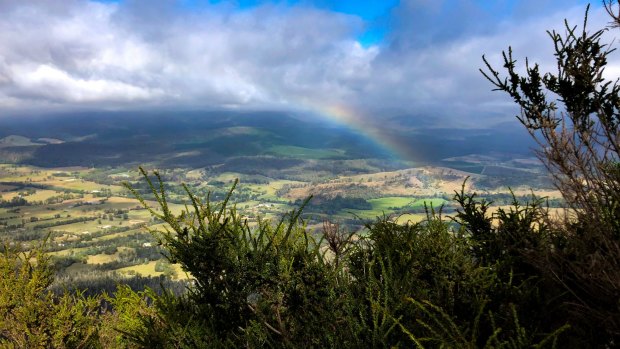
No matter how dark it seems now, the sun will shine again.Credit: Karl Quinn
I spent my last weekend of freedom hiking in the Cathedral Range, a couple of hours north-east of Melbourne. I'm no Nostradamus, but I had a sneaking suspicion it might be the last chance before the country went into shutdown, and so it more or less proved.
A hike is usually just a hike, but this one seemed to serve as a rolling metaphor: unexpected challenges; life clinging on tenaciously in the harshest of circumstances; mistakes being made and pants being pooped because, really, everything was far harder and scarier than anticipated.
Here's what I learned.
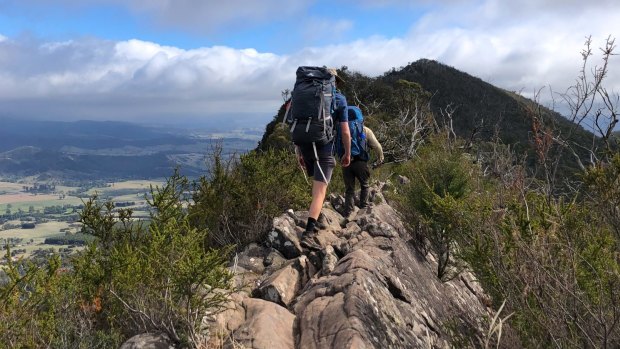
Hiking the Cathedral Range in Victoria often means walking atop a narrow sliver of sandstone on the ridge. Credit: Karl Quinn
We came at this late
My mate Mr T and I drove up after work on Friday, arriving long after the sun had gone down. We fumbled around in the dark, setting up tents and peeing in bushes and generally muddling through. Our mate R and the two teenagers in his company had been there hours, and had enjoyed an orderly set-up and dinner before retiring to bed.
In retrospect, planning ahead is a great idea.
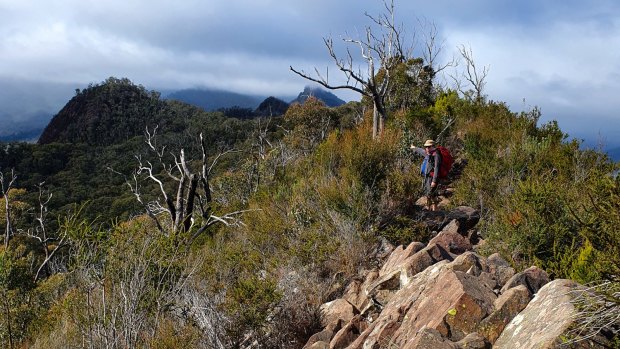
Not far to go now...Credit: Charles Todd
Self-isolation takes some getting used to
I finally got to use the one-person tent I'd bought more than a year ago, because in the circumstances none of us fancied top-and-tailing in a two-person. But I set it up wrong, and the blood rushed to my head, which was pointing downhill. I barely slept.
Mr T nailed it, though. He'd grabbed what he thought was a one-person tent from home, only to find it was actually a Quattro, intended either for four people or for women named Suzi. He had his very own four square metres all to himself.
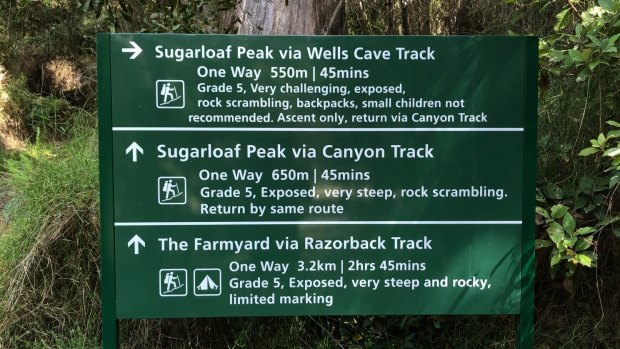
Ignore the signs at your peril.Credit: Karl Quinn
We're in for some seriously hard yards
The Cathedral Range consists of large slabs of stone tilted out of the ground at an angle of about 30 degrees (or 60, depending on which side of those slabs you're walking). Often, you walk beside them on a narrow path; almost as often, you walk on top of them. Occasionally, you go straight up them.
The word this hike repeatedly brought to mind was challenging. It could be the key word of our time.
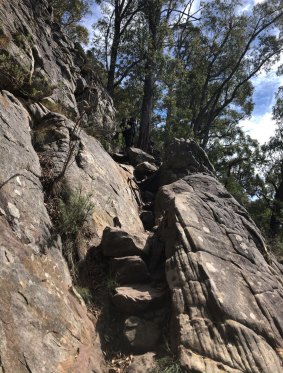
It only looks like a sheer vertical climb. Honest.Credit: Karl Quinn
Ignore the signs at your peril
Our small group did the entire circuit, roughly 20 kilometres, over two days. That meant carrying backpacks with tents and sleeping bags and water and food.
Ordinarily, that would be no big deal, but going is slow and our loads made passing through the narrow slit known as Wells Cave, and the near-vertical ascent on the other side of it, close to impossible.
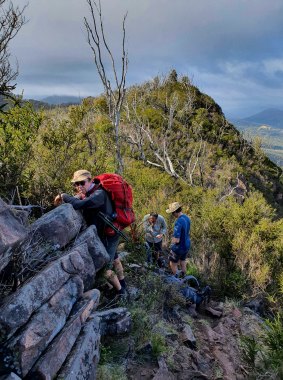
The author takes a breather on the northern circuit.Credit: Charles Todd
Even so, we ignored the signs - see how this thing works as metaphor? - that advise the cave option is not doable with backpacks. We got as far as the cave mouth before realising that whoever wrote those signs actually did know what they were talking about.
Luckily, there were teenagers in our group; that meant we could pretend we were only turning around on their account. I suspect the kids knew they'd have had a much better chance of surviving than we did, but they took pity and kept it to themselves.
There is no easy way out of this
We took the so-called easier option instead, up Canyon Track. This too involves a scramble up a rock face, on your belly, grasping desperately for leverage with hands and feet, while your backpack and gravity conspire to pull you off the mountain and down into the bush several hundred metres below.
I'd be lying if I said I was scared; terrified would be closer to the truth. As my foot slipped, my limbs ached and my mind struggled to discern a clear path up the rock face, I briefly thought the end was nigh. Somehow, though, I cleared my head, found a foothold, and kept going.
Coming out the other side feels soooo good
My exhilaration at reaching the top was immense. You're never more alive, I thought, than when you've felt the cold wind of death on the back of your neck.
A few minutes later, a couple of eight-year-old girls bounced up and over the ridge behind me, as if it were just another plastic obstacle course in the local park.
"Were you scared?" I asked one of them hopefully.
"Not really," she said. "But it was fnard."
"Fnard? What's that?"
"Fun-hard," she said.
I caught her father's eye, and realised something had been lost - or censored - in translation.
When the worst has passed, there'll still be miles to travel
That terrifying ascent came early in the walk. Over the next two days, there were some hairy moments, but nothing quite like that. One foot carefully in front of the other, eyes only occasionally lifted to take in the view as we tried to avoid trips, drops and twisted ankles - this was the new normal. The path was narrow, rocky, occasionally impossible to discern, even before the mist and rain rolled in. But we got there in the end.
Life goes on
These rocks were formed 400 million years ago beneath a shallow sea. Volcanic activity lifted them up, tilting them on their side as a caldera formed and collapsed.
The soil created by their weathering is harsh and thin. And yet nature abounds. Tiny plants have taken root in cracks in the slabs of dense, compacted sandstone. Trees dot the ridge. Lower down, the denser bush is home to lyrebirds and the insect life that sustains them.
No matter how tough things get, life goes on.
Yes it's going to be fnard. But with concentration, persistence and a little luck, we'll make it to the other side.
Follow the author on Facebook at karlquinnjournalist and on twitter @karlkwin
Sign up for the Traveller Deals newsletter
Get exclusive travel deals delivered straight to your inbox. Sign up now.